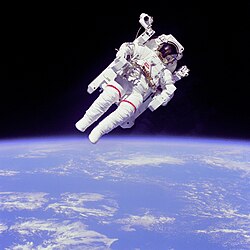Astronaut propulsion unit

An astronaut propulsion unit (or astronaut maneuvering unit) is used to move an astronaut relative to the spaceship during a
Models
Hand-Held Maneuvering Unit

The Hand-Held Maneuvering Unit was the
USAF Astronaut Maneuvering Unit

The United States Air Force (USAF) Astronaut Maneuvering Unit (AMU) was designed by the
Automatically Stabilized Maneuvering Unit (ASMU)

In 1973, the Automatically Stabilized Maneuvering Unit (ASMU) was test-flown aboard Skylab during the Skylab 3[4] and 4 missions. Tested inside of the orbiting laboratory, it used nitrogen gas allowing both unsuited and suited testing of the unit. The Skylab AMU was the closest to the Shuttle MMU, but was not used outside the spacecraft because the EVAs were conducted with the astronauts attached to life support umbilicals, and to prevent damage to the delicate solar arrays on the Apollo Telescope Mount.
Foot Controlled Maneuvering Unit (FCMU)
The Foot Controlled Maneuvering Unit was tested within Skylab. The purpose of it was to free the astronaut's hands. It was propelled by cold, high-pressured nitrogen gas located in a tank on the back.[5] It was tested both suited and unsuited.
Manned Maneuvering Unit

The Manned Maneuvering Unit (MMU) is a propulsion backpack which was used by NASA astronauts on three space shuttle missions in 1984. The MMU allowed the astronauts to perform untethered EVA spacewalks at a distance from the shuttle. The MMU was used in practice to retrieve a pair of faulty communications satellites, Westar VI and Palapa B2. Following the third mission the unit was retired from use.
Soviet SPK

The
The 21KS[6] system is a completely new design for Orlan-DMA spacesuit not using a safety tether, but air jet engines. This system was similar to MMU. It was automatically stabilized, used 6 degrees of freedom, weighed less than 180 kg, had a delta-v of 30 m/s, practical speed of 1 m/s, and an emergency mode that allows for rotational acceleration of 8°/s^2.[7]
SAFER
The Simplified Aid For EVA Rescue (SAFER) is a smaller backpack propulsion system intended as a safety device during space walks. It contains 1.4 kg of gaseous nitrogen, which provides much less delta-v capability than the MMU, roughly 10 feet per second (3 meters per second). However SAFER is less complex, less expensive and simpler to use than the MMU, and the limited delta-v is sufficient for the intended rescue-only task. Other Crew Self Rescue (CSR) devices of which prototypes have been developed include an inflatable pole, a telescoping pole, a bi-stem pole and a bola-type lasso device (astrorope) the drifting astronaut could throw to hook to the space station.
References
- ISBN 0-425-17987-7.
- ISBN 0-387-27919-9.
- OCLC 29845663.
- ^ Leland F. Belew, ed. (1977). "SP-400 Skylab, Our First Space Station, Chapter 7 -- The Second Manned Period". George C. Marshall Space Flight Center.
- ^ Millbrooke, Anne (1998). "From Engineering Science To Big Science, Chapter 13 -- More Favored than the Birds: The Manned Maneuvering Unit in Space".
- ^ ISBN 1-85233-732-X.
- ^ Igor Afanasiev & Dmitry Vorontzov (2010). "Cosmonaut's Personal Transport". Vokrug Sveta. Moscow. Retrieved September 29, 2013.
Further reading
- Suited for spacewalking a teacher's guide with activities for technology education, mathematics, and science. DIANE Publishing. p. 34. ISBN 978-1-4289-2748-3.
External links
- "More Favored than the Birds": The Manned Maneuvering Unit in Space
- NASA Manned maneuvering unit: User's guide - 1978 (PDF document)
- Assessment of the NASA Manned Maneuvering Unit - 1988 (PDF document)
- Astronautix SPK
